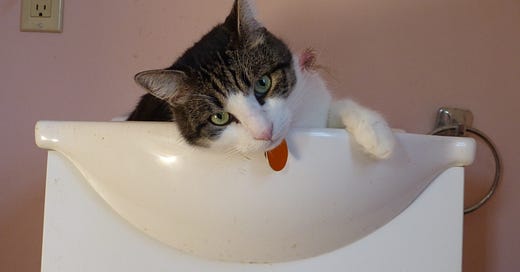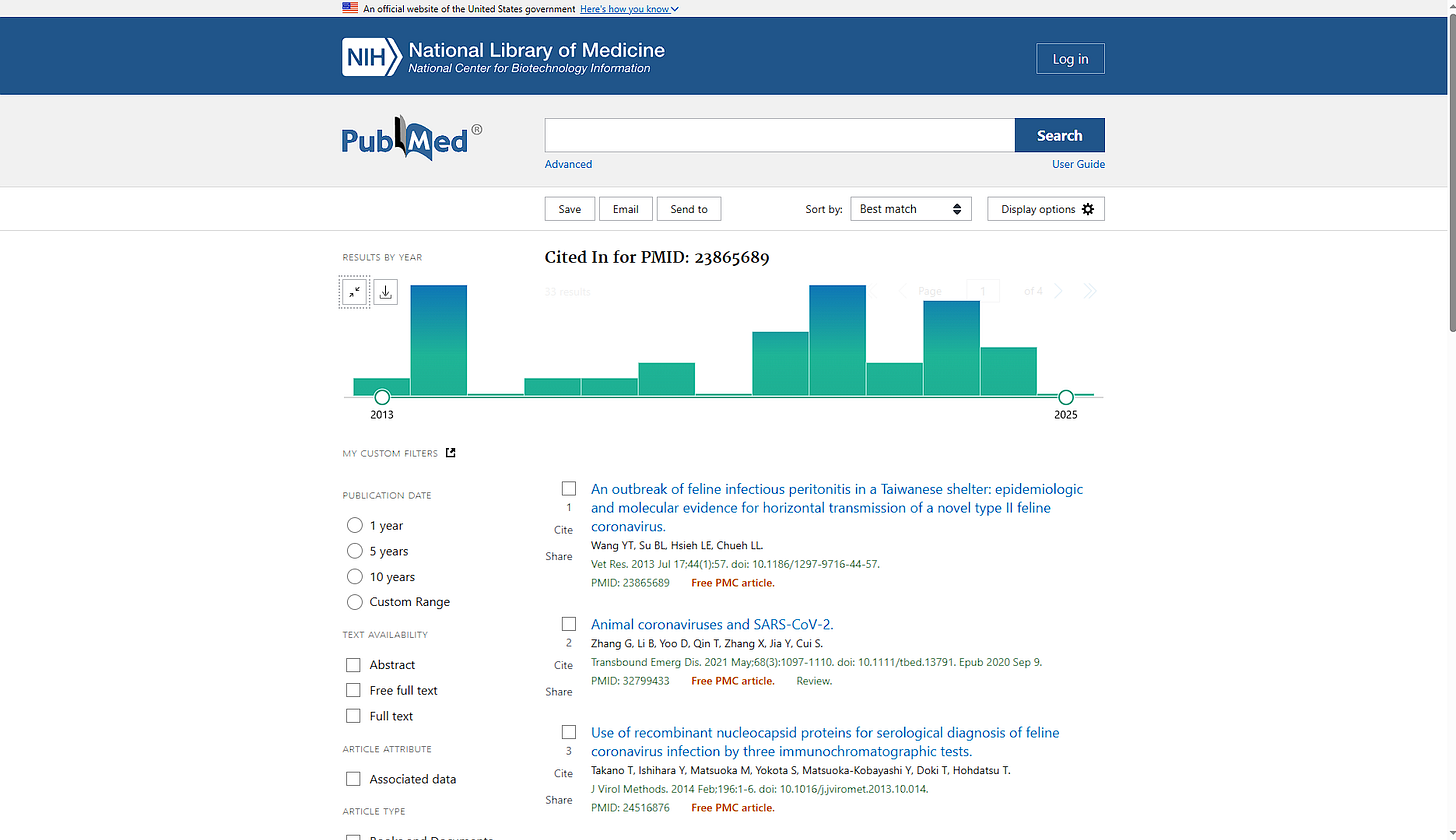Would it be FIPpin' possible?
...to take the 'body' of one coronavirus of one species and add the entire spike of another coronavirus from a different species and end up with something that would actually still be infectious?
The short answer is yes. Let me get a little lengthy now…
Feline Infectious Peritonitis(FIP) is a diagnosis that up until a few years no cat owner wanted to hear, because the outcome would have been 100% fatal. FIP was first described as a distinct disease in 1963 by Dr. Jean Holzworth from Angell Memorial Animal Hospital in Boston. (History of FIP from 1963-2022)
Initially described as
a diffuse inflammation of the tissues lining the peritoneal cavity and abdominal organs with extensive inflammatory fluid effusion
soon after a second form was described in 1972 which
manifested by less diffuse and more widespread granulomatous lesions involving organ parenchyma
Because of the absence of peritoneal effusions in the second form, it was named the ‘dry‘ form, versus the more common ‘wet‘ form.
It was not until 1968 that the it was determined to be cause by a virus, which was identified as coronavirus in 1970, which was found to be closely related to other coronaviruses found in dogs and swine in 1978.
It took up until 1995(!), seventeen years, for scientists to figure out that the virus that was found in cats with FIP, which was termed FIPV(Feline Infectious Peritonitis Virus) was only a mutant of the FeCV(Feline enteric Corona Virus; sometimes the ‘e’ is capitalized), which is ubiquitous worldwide in cats older than 9-10 weeks and is found to target the intestinal epithelium.
The mutations of the FIPV allows it to leave the epithelium and infect monocytes and macrophages, thus making its way into other areas, tissues and organs of the cat. Apart from now being able to travel to other tissues, it mostly loses the ability to be shed as the FeCV is. I say mostly, because the history article I am referencing includes information up to the year 2022. I will come back to this later.
Furthermore it was identified, that there are two distinctly different serotypes, evident by the different antibodies produced to an epitope of the S protein. Serotype I by cat sera and is the predominant type in most countries. Serotype II Feline Corona Viruses (FCoVs) are the result of a recombination of the spike with part of a canine coronavirus, which are the recognized by antibodies neutralizing canine coronavirus.
Up until 2013, it was believed that the spread of FIP was enzootic, meaning that there was little to no horizonal spread between cats of the FIPV and it was only the mutation of FeCV inside the individual cat that mutated and led to FIPV. It was shown that cats infected with FIV (Feline immunodeficiency virus) are more susceptible to FeCV mutating into FIPV.
In 2013 a paper described what was then the first epizootic cluster was in a shelter in Taiwan that housed cats and dogs, where a serotype II virus had evolved and spread to cats in the shelter. Necropsies and histopathological examinations showed that the cats that had succumbed to FIP all were infected with the same serotype II virus and that that virus could be detected in feces up to six days before death.
Further reading:
Fast forward to the year 2023. In the third year of the SARS-CoV2 pandemic there was an outbreak of FIP in Cyprus, an island in the Mediterranean Sea. As with the 2013 shelter outbreak, it was again a serotype FCoV that was responsible. Only this time, it was not a recombination of a FeCV with some portion of a canine coronavirus. It was a combination of a FeCV with the entirety of a spike protein from a a canine coronavirus.
In 2023, we alerted the veterinary field to an outbreak of FIP in Cyprus, where there had been a concerning increase in cases11. Cases were recorded as FIP only if they had compatible clinicopathological signs and a positive RT-qPCR for FCoV in one of the following samples; peritoneal fluid, pleural fluid, cerebrospinal fluid, fine needle aspiration biopsies, or tissue biopsies from granulomatous lesions or positive FCoV immunohistochemistry (IHC) of granulomatous lesions (IHC). RT-qPCR confirmed FIP cases had increased from three and four in 2021 and 2022, respectively, to 215 cases (186 thereof in 2023) from January 2023 to June 2024, representing more than a 50-fold increase.
And it was not only almost the entire spike of a canine coronavirus, either.
The first S sequence is most closely related to an FCoV-1 (MT444152) with 79% similarity, which occurred in one Cypriot and one UK-import sample. The others are almost entirely CCoV-2 S, flanked by FCoV-1 sequence. The CCoV-2 sequence is most closely related to the NA/09 strain (JF682842), a hypervirulent pantropic canine coronavirus (pCCoV)35, at 96.5% sequence identity.
And here is where I think everyone, who has been paying attention in the last 5 years should be getting just a little suspicious. FCov-23 is so far the only identified FIPV that is a chimera where the spike is almost entirely coming from a HYPERVIRULENT canine virus. A virus where one part comes from one species and the other part comes from another species.
I do not what you may be thinking right now, but my thinking goes along these lines:
It just so happens, that during a pandemic with a virus that we now know is deemed to have emerged because of gain-of-function research in a laboratory at Wuhan, China (I would argue with the help/assistance/involvement of an international team of scientists), by secret services and agencies of the US, Britain and Germany (add others that have publicly stated this as well), we end up with an outbreak of a unique chimeric virus in the capital of a small island, that is hypervirulent because of the spike protein involved in a disease which, up to a few years, was 100% fatal if not treated.
Presently, it is unclear how long cats infected with FCoV23 remain infectious for. As with classical FIP cases, if no treatment is initiated then the infection will result in the cat’s death; euthanasia should be considered on welfare grounds.
Oh, and before I forget, and you may find this really funny, if you are not involved with a cat rescue or a cat owner yourself. Do you want to make a guess as to the treatment option that is available since about 2018? Have you heard of compound GS-441524? No? I am sure you have heard though of the company that developed this drug. Gilead Sciences. You have not heard of them? Hm. Maybe you have heard of Remdesivir?
GS-441524 is the main plasma metabolite of the prodrug Remdesivir. Gilead had refused to license GS-441524 for veterinarian use for a long time. GS only became legally available in Australia, the Netherlands and the UK in 2023 and in the US in June of 2024. During the time when it was officially illegal, there were groups of cat rescuers and cat lovers who basically organized a black market for this drug, because of the astounding efficacy and almost negligible side effects.
GS-441524 treatment is amazingly free of systemic side effects. It can cause minor kidney damage in some cats, but this does not progress to overt renal disease.
(https://ccah.vetmed.ucdavis.edu/sites/g/files/dgvnsk4586/files/inline-files/Summary%20of%20GS-441524%20treatment%20v5.pdf)
One group in particular used the awesome reach of social media to inform cat owners and veterinarians of this treatment which 80% recovery rate (or more), when treatment is started as soon as possible. That group used Facebook and was called FIP Warriors. You will notice the 5.0. That is because they were continually taken down by Meta. So now it is there 5th attempt.
And there are others, too.
Just a quick personal story that I observed just this last week, before I get back to the main part of the story. My wife works with a cat rescue group and we have fostered a lot of cats over the last years. Just about 2 weeks ago one of our foster cats who had been adopted a few months ago, developed severe ataxia, seizures and loss of appetite. The owner contacted our rescue group, cause we always tell the new cat moms and dads in case of anything going wrong with “our“ cats to let us know.
After the regular veterinarian was not able to come up with a diagnosis, because symptoms can be varied in FIP wet and dry, but dry specifically, the owner was desperate and debating whether to go to an emergency clinic on a Saturday evening. My wife and I have been at that point often enough to know most of the time and sadly at the emergency clinics around us, they will not do a lot of stuff until the next Monday. In this case the clinic actually told the owner they will do supportive care until Monday. According to what we saw on the videos the owner send us, we knew by Monday that cat would be dead.
So we told the owner to come in and we started treatment with GS. Luckily we have a vet that works closely with the rescue group. Two doses, 12 hours apart and 24 hours after start of treatment, the cat is walking, eating and does not have seizures any more and is on its way to recovery. My take from this: if you own a cat, do make sure that your vet is well informed when it comes to FIP and possible treatment wit GS. Make sure to look for cat rescue groups in your area. Get in contact with them. Most of the time they are very knowledgeable about FIP and GS.
Back to the main part of this story. So we have a a pandemic. We have an outbreak of a chimeric new FIP virus in 2023. We have a treatment that works in a virus to a huge degree and has been proposed in a different virus that has been unsuccessfully treated with Remdesivir. Furthermore the CEO of the biggest profiteer of the pandemic, Pfizer, is a veterinarian. The former head of the German Robert Koch Institute as well.
Are all of these data points pure coincidence?
And before I leave you alone with your thoughts on that question, here is one last interesting tidbit I want to show you. For some weird reason some scientist have looked at what has been going on in the last 5 years and decide to try something new with something old. Create a vaccine based on the mRNA/LNP technology but instead of using the spike as the encoded protein to be produced, they use a protein from the internal structure of the virus that causes FIP: the nucleocapsid or N-protein. What a novel concept.
It goes to show, not just humans, bats, pangolins and racoon dogs can have coronaviruses. And maybe scientists are not just using the ones I just listed for their gain-of-function research?
Further reading material:
https://pmc.ncbi.nlm.nih.gov/articles/PMC7168551/
https://www.frontiersin.org/journals/immunology/articles/10.3389/fimmu.2022.857322/full
https://pmc.ncbi.nlm.nih.gov/articles/PMC7117484/
https://www.vet.cornell.edu/departments-centers-and-institutes/cornell-feline-health-center/health-information/feline-health-topics/feline-infectious-peritonitis
https://ccah.vetmed.ucdavis.edu/cats/resources/feline-infectious-peritonitis-clinical-trials
https://ccah.vetmed.ucdavis.edu/sites/g/files/dgvnsk4586/files/local_resources/pdfs/pedersenfipinterview9-10-08.pdf
https://www.ucdavis.edu/health/news/coronavirus-disease-cats
https://ccah.vetmed.ucdavis.edu/sites/g/files/dgvnsk4586/files/inline-files/Review%20FIP%201963-2022%20final%20version%20April%202022.pdf
https://pubmed.ncbi.nlm.nih.gov/29769478/
https://pmc.ncbi.nlm.nih.gov/articles/PMC7168551/
https://www.biorxiv.org/content/10.1101/2023.11.08.566182v3.full
https://www.pure.ed.ac.uk/ws/portalfiles/portal/394450456/231110_Imported_case_for_FIP_final.pdf
https://ccah.vetmed.ucdavis.edu/sites/g/files/dgvnsk4586/files/inline-files/Neurological-and-ocular-FIP-v4_1.pdf
https://ccah.vetmed.ucdavis.edu/sites/g/files/dgvnsk4586/files/inline-files/Summary%20of%20GS-441524%20treatment%20v5.pdf
https://fipwarriors.com/home








